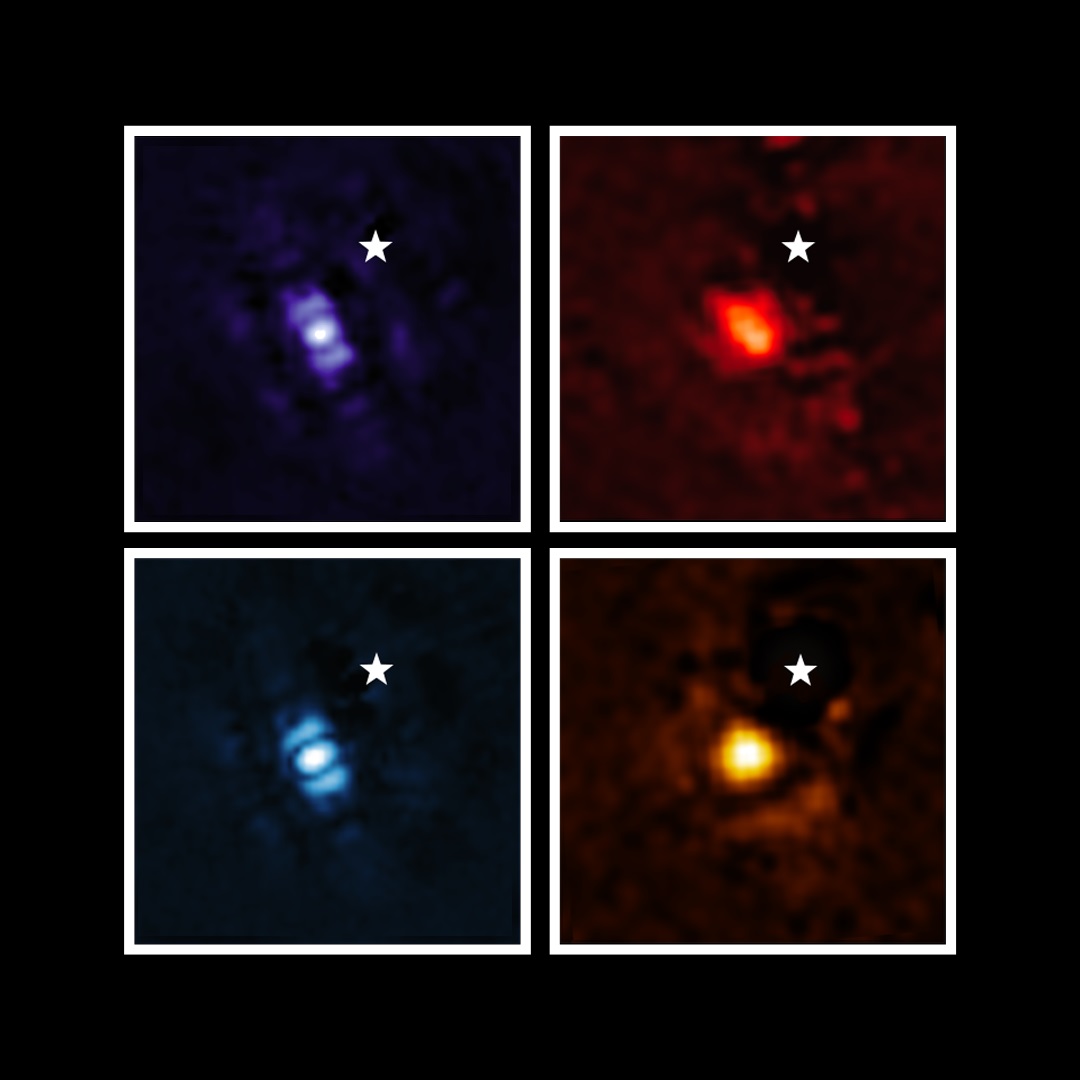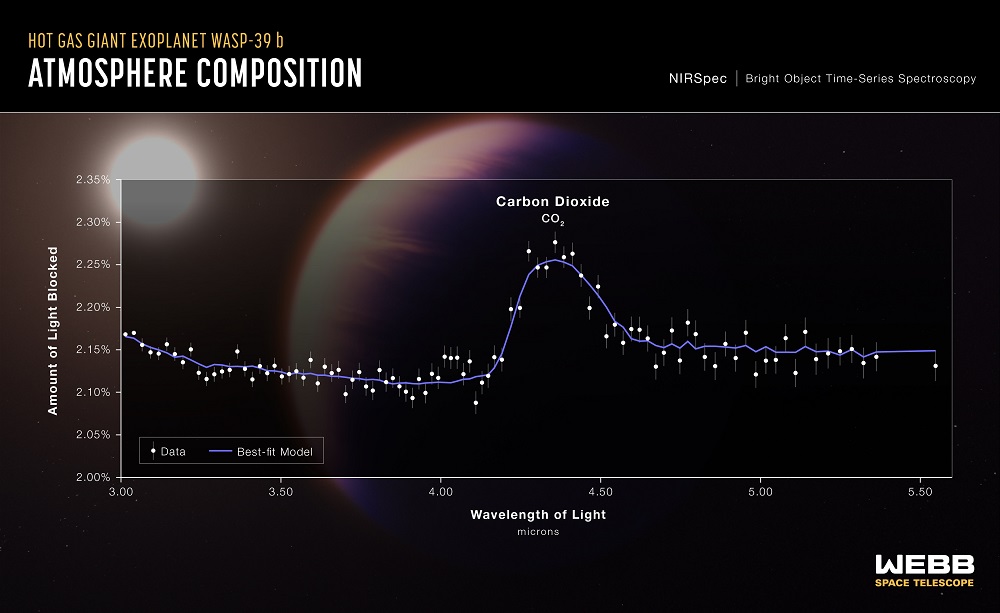In two groundbreaking firsts, NASA’s James Webb Space Telescope captured a direct image of an exoplanet, or a planet outside our solar system, as well as the first clear evidence for carbon dioxide in the atmosphere of an exoplanet. The observations, made with the powerful infrared (IR) telescope, provide insight into the formation and composition of planetary objects. More broadly, they also show the advantages that space telescopes hold outside Earth’s orbit.
WASP-39 b is the exoplanet on which Webb discovered the presence of carbon dioxide. The planet was itself first discovered in 2011 when ground-based observatories noticed the periodic dimming of the planet’s host star. This method of detection, when the presence of the planet is sensed by looking at the star, is known as indirect detection.
“Direct detection is when you can actually take a picture of something,” said Don McCarthy, distinguished professor of astronomy at the University of Arizona. McCarthy is an astronomer at the university’s Steward Observatory, and he helped design Webb’s Near-Infrared Camera (NIRCam) — the device that captured Webb's first image of the exoplanet HIP 65426 b.

The exoplanet HIP 65426 b in different bands of IR light, as seen from the James Webb Space Telescope. The Near-Infrared Camera (NIRCam) instrument’s view at 3 μm (purple). The instrument’s view at 4.44 μm (blue). The Mid-Infrared Instrument's (MIRI's) view at 11.4 μm (yellow). The MIRI instrument’s view at 15.5 μm (red). A set of masks, called a coronagraph, within each instrument blocks out the host star’s light so that the planet can be seen. The location of the host star HIP 65426 has been subtracted (small white star) using the coronagraphs and image processing. The bar shapes in the NIRCam images are artifacts of the telescope’s optics, not objects in the scene. Courtesy of NASA/ESA/CSA, A Carter (UCSC), the ERS 1386 team, and A. Pagan (STScI).
HIP 65426 b was discovered in 2017 using the SPHERE instrument on the Very Large Telescope in Chile, operated by the European Southern Observatory. In contrast to WASP, HIP was directly detected. SPHERE took images using short-IR wavelengths, aided by a coronagraph that filtered out some of the starlight, and by the planet’s distance from its host star (about 100× farther than Earth is from the sun).
Direct detection is a difficult task for ground-based telescopes. Host stars are much brighter than the planets that orbit them. HIP, for example, is more than 10,000× fainter than its host star in the near-infrared, and a few thousand times fainter in the mid-infrared. Directly imaging an exoplanet is often compared to imaging a firefly next to a search light, McCarthy said.
In addition to issues of brightness, problems are posed by Earth’s atmosphere. When light enters through the atmosphere, it passes through the air, causing turbulence that changes its wavefront.
Ground-based telescopes deal with this by using adaptive optics. A laser, sometimes called a guide star, is pointed out into the atmosphere, allowing the turbulence to be measured and compensated for.

“You can make a telescope behave as though it’s in space, although there is always some residual effect of the atmosphere,” McCarthy said.
Michael Line, a professor of astronomy at Arizona State University, also noted the advantage of space-based observations, citing the effects of the atmosphere.
“We have processing methods that can help remove these contaminating effects when observing from the ground, but nothing can beat the pristine space environment,” he said. “More specifically, it’s incredibly difficult to observe infrared wavelengths longwards of ~3 to 5 µm or so.”
The Earth’s atmosphere glows in the infrared, which adds to the noise. Large telescopes can lower this noise, Line said. Still, space holds the advantage.

A transmission spectrum of the hot gas giant exoplanet WASP-39 b, captured July 10 by Webb’s Near-Infrared Spectrograph, reveals the first clear evidence for carbon dioxide on a planet outside the solar system. This is also the first detailed exoplanet transmission spectrum ever captured that covers wavelengths between 3 and 5.5 µm. Courtesy of NASA, ESA, CSA, and L. Hustak (STScI).
Although the Hubble Space Telescope (HST) is outside of Earth’s atmosphere, the fact that it orbits Earth poses other challenges.
“HST orbits the Earth every 90 min,” Line said. “Therefore, for a given target, if you wanted to observe it for more than 90 min, you’d have gaps in your data as the Earth gets in the way. For transiting planets, we want to observe the whole transit event (and a little before and after), which could span several hours or more. This means we have to contend with these gaps in the data.”
According to Regents’ Professor of Astronomy Marcia Rieke at the University of Arizona, who is principal investigator on Webb's NIRCam, a major aspect of Webb’s advantage for exoplanet observation lies in its positioning.
“Observing exoplanet transits requires a stable instrument,” she said. Because Webb sits at Earth-Sun L2, which is outside of Earth’s orbit, it has a very stable environment. The lack of background infrared noise and atmospheric disturbances also facilitate Webb’s prowess in exoplanet observation.
McCarthy said, “You’re much better off looking for exoplanets with James Webb because of its stability. And it’s just tuned for the right wavelengths.”
Webb’s ability to look into the longer IR range makes it uniquely suited for looking at exoplanets. The planets primarily emit in the infrared range, McCarthy said. “The [Webb] would be looking at the planet where it is at its brightest because of its natural temperature.” In the IR range, the star would appear fainter, in a relative sense, than it would in the visible range. This grants Webb an advantage in imaging due to the increased contrast.
Webb’s infrared range goes far beyond what any ground-based telescope can feasibly observe in. According to Line, wavelengths upwards of 3 to 5 μm pose problems for ground-based observatories.
Rieke said, “[Webb] can observe complete spectra from 0.7 to 28 µm with no missing wavelengths due to either atmospheric absorption or OH [hydroxyl] airglow lines.” This broad wavelength range allows the telescope to study a broad range of molecular species.
“What will be especially exciting, I think," McCarthy said, "is if you observe one of these transiting planets and you see oxygen, like ozone, evidence in the planet’s atmosphere. Historically, people have said that oxygen is so reactive a molecule that something has to generate it, like life of some sort.”